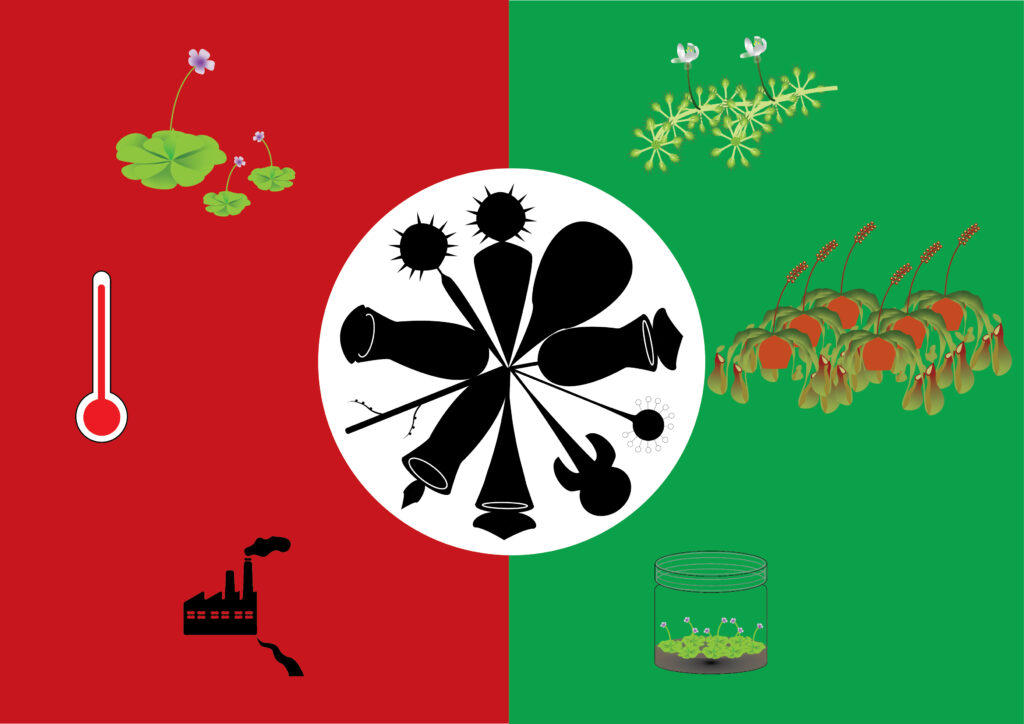Carnivorous plants are popular ornamental plants for their unique appearance and special structures that prey animals. But not many growers are aware of the situation that many of the carnivorous plant species are classified as endangered, such as Aldrovanda sp. and some may have become extinct species. Several factors may cause them to be endangered and extinct directly or indirectly.
First, the propagation method of carnivorous plants in nature. Many of the carnivorous plants are propagated through the splitting of the baby plants from the mother plants in which it is known as one of the most effective propagation methods. However, in an environment without human activity, most of the carnivorous plants have to rely on the runner that regenerate the offsets as well as seed dispersion solely. Seed dispersion is suitable for species such as Drosera sp. that able to produce the seeds via self-pollination. On the other hand, seed dispersion is less likely to be useful as there is a need for specific pollinators to cross-pollinate the carnivorous plants. For instance, the seeds of Sarracenia sp. must be cross-pollinated from a plant to another plant of the same species or different species. Due to the trapping mechanism of the carnivorous plant in nature, it limited the species of the pollinators into very few species. Therefore, it is only possible if there is luck in which the pollinators appear and to the job. Moreover, the carnivorous plants have to grab the correct timing to bloom for pollination in the presence of another plant and pollinator. Furthermore, after successful pollination occurred, some of the seeds produced are not going to germinate readily. For example, the seeds of Cephalotus take a very long time to grow and the seeds cannot remain viable for a very long period.
Second, global warming leads to climate change. Most carnivorous plants require cold and humid conditions. Increase in global temperature which is unfavored by the growth condition of the carnivorous plants that led to the wilt and dead of the plants. Global warming also brings a negative impact to the pollination of carnivorous plants in which the pollinators may migrate to another ecosystem leaving unpollinated carnivorous plants. Third, it also due to human activities such as the collection of the species from the wild, deforestation, and industrial activities that bring pollution to the environment. Due to the unique color, shape, and form of the varieties of the carnivorous plants, many species and varieties of the carnivorous plants that found in the forest were harvested and collector by hobbyist and carnivorous plant hunter. Deforestation that changed the ecosystem drastically may cause the migration of the pollinators indirectly. It also changed the microclimate which is no longer suitable for carnivorous plants to survive. Besides, Industrial pollution such as water pollution that resulted in eutrophication (algal bloom). This phenomenon caused the endanger aquatic carnivorous plant, Aldrovanda to be extinct for some areas.
However, thanks to the collection activities of the carnivorous plants by collectors from the wild, the germplasm of the carnivorous plants are well preserved in the artificial growth environment, greenhouse. This is known as ex-situ conservation, where the plants are conserved in a new area from the place it is found. Many exotic carnivorous plant species had been collected from the forest and propagated at a commercial scale in nurseries. Moreover, with the aid of plant tissue culture, seeds of carnivorous plants can be germinated quickly with a much higher germination rate as compared to the seed germination in nature. Thus, these commercial propagations on carnivorous plants helped to secure the plants from being endangered species and extinction.
